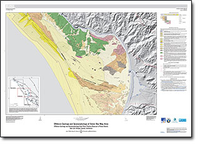Offshore geology and geomorphology from Point Piedras Blancas to Pismo Beach, San Luis Obispo County, California
Links
- More information: USGS Index Page
- Document: Pamphlet (95 KB pdf)
- Plates:
- Companion File: Data catalog
- Metadata: Metadata
- Download citation as: RIS | Dublin Core
Abstract
Marine geology and geomorphology were mapped along the continental shelf and upper slope between Point Piedras Blancas and Pismo Beach, California. The map area is divided into the following three (smaller) map areas, listed from north to south: San Simeon, Morro Bay, and Point San Luis. Each smaller map area consists of a geologic map and the corresponding geophysical data that support the geologic mapping. Each geophysical data sheet includes shaded-relief multibeam bathymetry, seismic-reflection-survey tracklines, and residual magnetic anomalies, as well as a smaller version of the geologic map for reference. Offshore geologic units were delineated on the basis of integrated analysis of adjacent onshore geology, seafloor-sediment and rock samples, multibeam bathymetry and backscatter imagery, magnetic data, and high-resolution seismic-reflection profiles. Although the geologic maps are presented here at 1:35,000 scale, map interpretation was conducted at scales of between 1:6,000 and 1:12,000.
Sea level was approximately 120 to 130 m lower during the Last Glacial Maximum (about 21 ka). This approximate depth corresponds to the modern shelf break, a lateral change from the gently dipping (0.8° to 1.0°) outer shelf to the slightly more steeply dipping (about 1.5° to 2.5°) upper slope in the central and northern parts of the map area. South of Point San Luis in San Luis Bay, deltaic deposits offshore of the mouth of the Santa Maria River (11 km south of the map area) have prograded across the shelf break and now form a continuous low-angle (about 0.8°) ramp that extends to water depths of more than 160 m. The shelf break defines the landward boundary of slope deposits. North of Estero Bay, the shelf break is characterized by a distinctly sharp slope break that is mapped as a landslide headscarp above landslide deposits. Multibeam imagery and seismic-reflection profiles across this part of the shelf break show evidence of slope failure, such as slumping, sliding, and soft-sediment deformation, along the entire length of the scarp. Notably, this shelf-break scarp corresponds to a west splay of the Hosgri Fault that dies out just north of the scarp, suggesting that faulting is controlling the location (and instability) of the shelf break in this area.
Study Area
| Publication type | Report |
|---|---|
| Publication Subtype | USGS Numbered Series |
| Title | Offshore geology and geomorphology from Point Piedras Blancas to Pismo Beach, San Luis Obispo County, California |
| Series title | Scientific Investigations Map |
| Series number | 3327 |
| DOI | 10.3133/sim3327 |
| Year Published | 2015 |
| Language | English |
| Publisher | U.S. Geological Survey |
| Publisher location | Reston, VA |
| Contributing office(s) | Pacific Coastal and Marine Science Center |
| Description | Pamphlet: iii, 6 p.; 6 Sheets: 49.0 x 36.26 inches or smaller; Metadata; Data catalog |
| Country | United States |
| State | California |
| County | San Luis Obispo County |
| City | San Simeon |
| Other Geospatial | Morro Bay, Point San Luis |
| Projection | Universal Transverse Mercator projection, Zone 10N |
| Scale | 35000 |
| Online Only (Y/N) | Y |
| Additional Online Files (Y/N) | Y |


